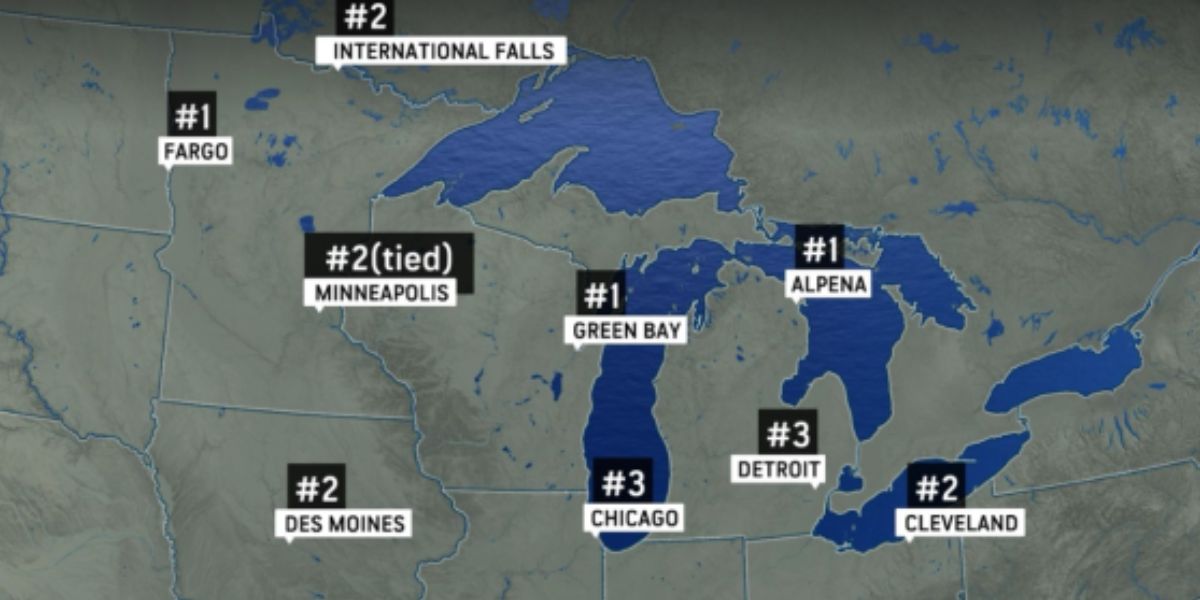Winter’s Warm Wrath: $8 Billion in Economic Losses for Northern Plains Enterprises
Families and businesses may have saved money on heating and snow removal following a record mild winter in most of the northern Plains and Upper Midwest, but the lack of cold weather had a significant impact on the regional economy. This winter, dozens of outdoor events and traditions, such as ice fishing competitions, ice castle festivals, ice skating, ice fishing, and ice hockey, were reduced, delayed, or canceled due to extremely high temperatures and a lack of ice on the lakes. Minnesota, North Dakota, Wisconsin, Michigan, and Iowa all recorded their warmest winters on record.
This past winter, ice coverage in the Great Lakes fell to near-record or all-time lows.
This winter, less than 30 inches of snow fell at Minneapolis-St. Paul International Airport, which is about 55% of the seasonal average.
Lack of Cold, Snow, and Ice Costs Businesses Billions
AccuWeather specialist meteorologists predict that the warm winter weather in the northern Plains and Upper Midwest has cost around $8 billion in economic damage and loss.
Seasonal workers were reportedly laid off, and losses were claimed at dozens of resorts, outdoor leisure enterprises, and snow removal organizations.
Economic injury disaster loans from the United States Small Business Administration have been made available to hospitality and tourism businesses impacted by a lack of cold, snow, and ice in dozens of counties across Minnesota, Wisconsin, and Michigan as part of an ongoing federal drought declaration.
AccuWeather’s economic loss estimate incorporates independent methods to evaluate direct and indirect weather impacts, includes insured and uninsured losses, and is based on a variety of sources, statistics, and unique techniques AccuWeather employs to estimate impact and loss to various sectors of the economy. It also includes the long-term effects on business operations, transportation, and tourism, as well as the costs of previously unreported problems.
To put this event in context, AccuWeather scientists calculated that the overall damage and economic loss from flooding, washouts, and mudslides caused by Hurricane Hilary in California and the Southwest United States last February ranged from $9 billion to $11 billion. AccuWeather anticipated Hurricane Idalia’s damage and economic cost in August 2023 to be between $18 billion and $20 billion.
The wildfire in Hawaii last August caused estimated damage and economic loss of $14 billion to $16 billion. AccuWeather researchers estimate that Hurricane Nicole produced $5 billion to $7 billion in damage and economic losses in November 2022.
Why Was This Winter So Warm?
Winter temperatures in the northern Plains and Upper Midwest have risen by an average of 4 to 5 degrees Fahrenheit since the turn of the twentieth century.
According to AccuWeather Senior Meteorologist Brett Anderson, this region has the highest warming winter trend of any area in the lower 48 states.
“On average, there has been a five- to a 20-day reduction in the number of ‘extreme cold days’ in the Upper Midwest and northern Plains, compared to historic average back in the late 1940s,” he added. “Some locations are seeing less snowfall, while others are receiving more. The main cause is that the region’s winters are becoming more wet. In most northern places, it is still chilly enough to see snow rather than rain or a wintry mix. As winter temperatures rise, more locations may have lower yearly snowfall by the end of the century.”
Anderson attributes the lack of snow to the strong El Niño this winter. During El Niño winters, the northern Plains and Upper Midwest have less snowfall due to a primary storm track that skips the region.
“The combination of a strong El Niño and climate change has played a role in the lack of cold air across much of the northern Plains and Upper Midwest this winter,” he said. “In terms of a lack of snow, El Niño appears to be the key factor to blame.”
Early Signs of Hope for Next Winter?
Following a record-breaking winter of hot temperatures that slammed the tourism industry hard, AccuWeather expert meteorologists believe there are early signs of lower temperatures and increased potential for snow in 2024-2025.
There is an increasing possibility that we will convert to a La Niña trend by this fall or winter. If that happens, colder air and snowier conditions may return to the northern Plains and Upper Midwest,” Anderson explained. “More ice could return to the Great Lakes as well, after a winter with record-low ice coverage.”











